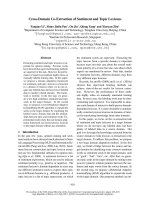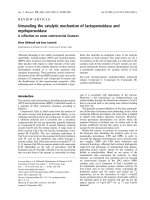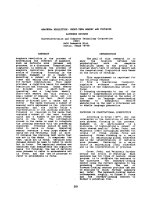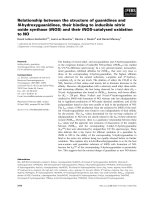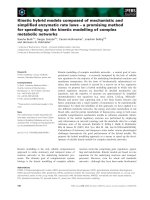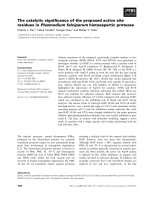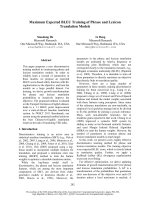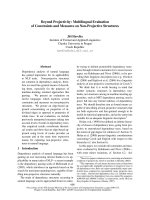Báo cáo khoa học: "Genetic transformation: short review of methods and their applications, results and perspectives for forest trees" ppt
Bạn đang xem bản rút gọn của tài liệu. Xem và tải ngay bản đầy đủ của tài liệu tại đây (732.95 KB, 12 trang )
Review
article
Genetic
transformation:
a
short
review
of
methods
and
their
applications,
results
and
perspectives
for
forest
trees
L Jouanin
ACM
Brasileiro
JC
Leplé
G
Pilate
D
Cornu
1
INRA,
laboratoire
de
biologie
cellulaire,
route
de
Saint-Cyr,
78026
Versailles
Cedex;
2
INRA,
station
d’amélioration
des
arbres
forestiers,
Ardon,
45160
Olivet,
France
(Received
10
September
1992;
accepted
11
February
1993)
Summary —
This
report
reviews
the
state-of-the-art
in
plant
genetic
engineering,
covering
both
di-
rect
and
indirect
gene
transfer
methods.
The
application
of
these
techniques
to
forest
trees
has
been
discussed
and
a
summary
of
the
published
results
given.
An
overview
of
the
possibilities
of
introduc-
ing
genes
of
agronomic
interest
to
improve
some
characteristics
such
as
resistance
to
pests
and
modifications
of
phenotypic
traits
has
been
examined.
Agrobacterium
I
biotechnology
I
forest
tree
I
genetic
transformation
Résumé —
La
transformation
génétique :
résultats
et
perspectives
pour
les
arbres
forestiers.
Cet
article
fait
le
point
sur
les
techniques
directes
et
indirectes
de
transformation
génétique
des
plantes.
Leur
application
pour
la
transformation
des
arbres
forestiers
est
discutée
et
une
liste
des
ré-
sultats
déjà
publiés
est
établie.
Les
différents
gènes
d’intérêt
agronomique
qui
peuvent
être
intro-
duits
afin
d’améliorer
des
caractères
comme
la
résistance
aux
pathogènes
et
des
modifications
du
phénotype
sont
détaillés.
Agrobacterium
/ arbres
forestiers
/ biotechnologie
/
transformation
génétique
INTRODUCTION
Biotechnology
includes
tissue
culture,
mo-
lecular
biology
and
genetic
transformation.
This
field
of
research
can
accelerate
tree
improvement
programs
in
a
number
of
ways.
Tissue
culture
not
only
offers
the
potential
to
multiply
selected
genotypes
ef-
ficiently
and
rapidly,
but
is
also
essential
for
the
multiplication
of
transformed
geno-
types.
Molecular
biology
and
genetics
pro-
vide
insight
into
the
nature,
organization,
and
control
of
genetic
variation
(Cheliak
and
Rogers,
1990).
* Present
address:
Embrapa/Cenargen,
Sain
Parque
Rural
70770,
Brazilia-DF,
Brazil.
Transgenic
plant
recovery
is
a
relatively
new
domain
and
was
first
attained
with
model
plants
such
as
tobacco.
The
intro-
duction
and
expression
of
foreign
DNA
in
a
plant
genome
requires
several
steps:
in-
troduction
of
DNA
into
a
cell,
selection
and
growth
of
this
cell,
and
regeneration
of
an
entire
plant.
Continuing
progress
is
made
in
obtaining
transgenic
plants
from
annual
crops.
However,
it
has
been
slower
in
tree
species
which
can
be
transformed
but
are
more
difficult
to
regenerate,
in
part
due
to
inefficiencies
of
in
vitro
culture
systems.
Thus,
many
public
and
private
laboratories
are
working
on
improving
tree
culture
sys-
tems.
In
this
paper,
we
provide
some
in-
sight
into
the
main
transformation
proce-
dures
developed
for
crop
plants
and
review
the
results
obtained
with
forest
trees.
GENETIC
TRANSFORMATION
METHODS
Different
systems
can
be used
to
introduce
foreign
DNA
into
a
plant
genome.
These
methods
include
biological
systems
based
on
the
pathogenic
bacteria
Agrobacterium
fumefaciens
and
A
rhizogenes,
or
physical
and
chemical
systems
such
as
microinjec-
tion,
electroporation,
chemical
poration
and
microprojectile
bombardment.
Many
other
ways
of
introducing
DNA
into
the
plant
cell
have
been
tested,
and
have
been
recently
reviewed
by
Potrykus
(1991
).
Agrobacterium-mediated
transformation
A
tumefaciens
and
A
rhizogenes
are
con-
sidered
as
natural
genetic
engineers
due
to
their
ability
to
transfer
and
integrate
DNA
into
plant
genomes
through
a
unique
intergeneric
gene
transfer
mechanism.
Both
are
phytopathogenic
bacteria
of
the
Rhizobiaceae
family. A
tumefaciens
is
the
causative
agent
of
crown
gall
disease
and
A
rhizogenes
is
responsible
for
hairy
root
disease.
These
bacteria
are
pathogenic
in
a
wide
range
of
dicotyledons
and
in
some
gymnosperms
(De
Cleen
and
De
Ley,
1976,
1981).
In
particular,
they
have been
the
cause
of
problems
in
vineyards
and
fruit
orchards
in
Eastern
Europe.
Monoco-
tyledons
are
naturally
resistant
to
Agrobac-
terium
infection
(De
Cleene,
1985).
These
diseases
are
caused
by
the
transfer
and
integration
into
the
plant
ge-
nome
of
a
portion
of
large
plasmids
(150-
200
kb)
called
pTi
(tumor-inducing
plas-
mids)
from
A
tumefaciens
and
pRi
(root-
inducing
plasmids)
from A
rhizogenes
(re-
viewed
by
Charest
and
Michel,
1991 ;
Hooykaas
and
Schilperoort,
1992 ;
Wi-
nans,
1992 ;
Zambryski,
1992).
The
genes
located
in
the
transferred
region,
called
T-
DNA
(transferred
DNA)
are
integrated
into
the
plant
genome
and
expressed
in
the
plant
cells.
Some
of
these
genes
(onco-
genes)
promote
hormone
synthesis
or
modifications
in
hormone
content
that
alter
the
growth
regulator
balance
of
the
plant
tissue,
thus
changing
their
growth
charac-
teristics.
The
tumors
obtained
after A
tu-
mefaciens
inoculation
result
from
the
expression
of
the
auxin
and
cytokinin
synthesis
genes
present
on
pTi
T-DNA.
In
the
case
of
A
rhizogenes,
expression
of
several
genes
called
rolA,
B and
C
(root-
including
loci)
induces
root
formation
at
the
inoculation
point.
Up
to
now
this
root
induc-
tion
mechanism
has
not
been
completely
elucidated.
The
T-DNA
genes
are
not
involved
in
T-
DNA
transfer
mechanism
and
can
be
re-
placed
by
other
genes
without
affecting
transfer
efficiency.
Two
direct
repeats
of
24
bp
at
the
borders
of
all
T-DNA
are
needed
for
their
efficient
transfer.
Another
sequence
named
overdrive
near
the
right
border
enhances
the
transfer.
The
other
essential
part
of
pTi
and
pRi
is
the
viru-
lence
region
(vir).
The
vir
genes
are
re-
sponsible
for
the
processing
of
the
T-DNA
and
its
transfer
to
the
plant
cell.
Figure
1
presents
a
schematic
map
of
the
Ti
plas-
mid
showing
the
most
important
regions,
the
vir-region
as
already
mentioned,
the
T-
region
(called
T-DNA
when
transferred
in
transformed
plant
cells)
and
the
regions
implicated
in
the
replication
of
the
plasmid
in
the
bacteria
and
in
the
conjugative
trans-
fer
between
bacteria.
For
plant
genetic
engineering
the
onco-
genes
need
to
be
deleted
from
pTi
as
they
are
not
compatible
with
regeneration.
En-
tire
plants
containing
pRi
T-DNA
can
be
re-
generated
from transformed
roots.
Howev-
er,
the
plants
expressing
pRi
oncogenes
present
a
specific
phenotype
(wrinkled
leaves,
root
plagiotropism
and
reduction
of
apical
dominance ;
Tepfer,
1984)
which
is
often
incompatible
with
their
use
in
plant
breeding
programs.
Two
different
strategies
can
be
used
for
gene
integration
with
the
Agrobacterium
system.
In
a
cointegrate
vector
(fig
2A ;
Zambryski
et
al,
1983),
pTi
T-DNA
onco-
genes
are
replaced
via
homologous
recom-
bination
by
a
DNA
fragment
containing
the
gene(s)
of
interest
and
if
necessary
a
mark-
er
gene
flanked
with
vector
sequences.
This
strategy
can
also
be
used
with
pRi
without
removing
the
oncogenes
which
al-
low
the
root
formation.
However,
the
strat-
egy
used
in
most
cases
involves
a
binary
system
(fig
2B ;
Hoekema
et al,
1983).
In
this
case,
the
agrobacteria
used
for
trans-
formation
contain
Ti
or
Ri
plasmids
with
in-
tact
virulence
regions
but
with
deletion
of
their
entire
T-region
(including
the
border
sequences).
These
are
termed
disarmed
strains.
The
gene
of
interest
and
if
neces-
sary
a
selectable
marker
gene
are
cloned
between
the
border
sequences
into
a
sec-
ond
small
plasmid.
For
plant
transforma-
tion,
the
binary
plasmid
is
introduced
into
a
disarmed
Agrobacterium.
The
most
cur-
rently
used
technique
to
obtain
transgenic
plants
is
the
cocultivation
of
plant
explants,
eg
leaf,
stem,
or
root
fragments,
embryos
with
the
Agrobacterium
containing
the
gene
of
interest
in
its
T-region.
During
this
cocultivation
step,
the
wounded
plant
cells
are
in
contact
with
the
Agrobacterium
and
the
transfer
of
T-DNA
occurs.
Then
the
agrobacteria
are
eliminated
and
the
plant
explants
are
transferred
onto
a
regenera-
tion
medium.
In
complement
to
the
ele-
ments
needed
for
regeneration
of
shoots,
the
medium
contains
2
kinds
of
antibiotics,
one
to
kill
the
residual
agrobacteria
(de-
contamination)
and
the other
to
select
the
transformed
plant
cells.
Figure
3
summar-
izes
the
different
steps
in
the
procedure
developed
for
poplar
stem
fragment
cocul-
tivation
according
to
Leplé
et al (1991).
Direct
gene
transformation
Direct
transformation
techniques
over-
come
Agrobacterium
host
range
limita-
tions.
These
methods
are
generally
based
on
the
use
of
protoplasts
or
tissues
from
which
efficient
regeneration
can
be
achieved.
With
these
methods,
transient
expression
(expression
of
the
introduced
gene
without
integration
in
the
plant
ge-
nome)
of
the
transferred
gene
is
often
ob-
served.
However,
stable
transformation
af-
ter
integration
in
the
plant
genome
can
also
be
achieved.
Different
means
can
be used
to
render
permeable
the
plant
protoplast
membrane
to
allow
uptake
of
naked
DNA.
Some
au-
thors
have
used
polyethylene
glycol
(PEG)
or
polyvinyl
alcohol
(PVA),
but the
transfor-
mation
frequency
has
sometimes been
low
(Kruger-Lebus
and
Potrykus,
1987).
An-
other
method
which
can
increase
the
transformation
rate
is
electroporation.
In
this
method,
after
or
without
pretreatment
with
PEG
or
PVA,
the
protoplasts
are
sub-
mitted
to
a
high-voltage
electric
pulse
which
enhances
DNA
penetration
into
the
plant
cell
(Crossway
et al,
1986 ;
Fromm
et
al, 1986).
Microjection
permits
direct
and
precise
delivery
of
DNA
into
the
plant
protoplasts
using
a
microsyringe
containing
the
DNA
in
solution.
However,
this
technique
is
ex-
tremely
delicate
and
requires
the
use
of
expensive
equipment
(Reich
et al,
1986).
Microprojectile
bombardment
is
a
novel
technique
in
which
small
tungsten
or
gold
particles
coated
with
DNA
are
accelerated
with
a
gun
to
velocities
that
permit
penetra-
tion
of
intact
cells
(Klein
et
al,
1987 ;
Chris-
tou
et
al,
1988 ;
Sautter
et
al,
1991).
The
use
of
intact
cells
or
tissues
is
a
major
advantage
because
it
bypasses
the
need
for
regeneration
procedures
from
proto-
plasts.
Moreover,
this
technique
allows
the
study
of
gene
expression
in
organized
tis-
sues
without
the
need
to
regenerate
entire
transformed
plants.
Many
other
techniques
have
also
been
tested
with
the
aim
of
introducing
DNA
into
plant
cells
(laser
microbeam,
pollen
tube-
mediated
delivery,
ultrasonication,
etc)
but,
in
most
of
them,
only
transient
expression
or
non-reproducible
results
have
been
ob-
served
(Potrykus,
1991).
All
of
these
tech-
niques
have
their
limitations.
The
transfor-
mation
method
selected
will
depend
on
the
species
and
characteristics
of
the
plant
to
be
transformed.
MARKER
GENES
Two
strategies
can
be
used
to
recover
transgenic
plants
after
transformation:
screening
of
all
regenerated
plants
for
ex-
pression
of
a
reporter
gene,
and/or
selec-
tion
of
transformed
plants
for
resistance
to
a
selectable
agent.
The
marker
genes
are
chimeric
constructions
containing
plant
expression
signals
fused
to
the
coding
sequence
of
a
gene
of
bacterial
or
other
origin.
These
regulatory
sequences
(pro-
moter
and
polyadenylation
signal),
allow-
ing
expression
in
plant
cells,
are
generally
derived
from
genes
of
the
pTi
T-DNA
(nop-
aline
synthase,
octopine
synthase,
manno-
pine
synthase,
etc)
or
from
the
19S
and
35S
transcripts
of
the
cauliflower
mosaic
virus.
Among
the
more
frequently
used
re-
porter
genes,
the
β-glucuronidase
(GUS)
gene
is
very
useful
since
its
enzyme
activi-
ty
can
be
easily
visualized
by
formation
of
a
blue
precipitate
in
the
presence
of
XGluc
(5-bromo-4-chloro-3-indolyl
glucuronide)
in
histochemical
assays
or
measured
by
fluo-
rimetry
in
the
presence
of
MUG
(4-methyl
umbelliferyl
glucuronide)
as
substrate
(Jef-
ferson
et
al,
1987).
The
introduction
of
a
plant
intron
into
the
coding
sequence
of
the
GUS
gene
prevents
its
expression
in
Agrobacterium.
This
characteristic
permits
the
first
steps
of
the transformation
to
be
followed,
since
it
allows
easy
visualization
of
the
transformed
plant
cells
without
the
problems
caused
by
the
presence
of
agro-
bacteria
at
the
inoculation
point
(Vancan-
neyt
et al,
1990).
Among
the
selectable
markers
used
to
select
transformed
cells
on
the
culture
me-
dia,
the
neomycin
phosphotransferase
(NPTII)
gene
(Fraley
et al,
1983 ;
Herrella-
Estrella
et
al,
1983)
is
widely
used.
The
expression
of
this
gene
confers
resistance
to
different
antibiotics
(kanamycin,
neomy-
cin,
paronomycin,
geneticin).
The
activity
of
this
selectable
gene
product
is
easily
detectable.
Hygromycin
phosphotransfe-
rase
(HPT,
Waldron
et
al,
1985)
is
also
very
efficient
but
less
frequently
used
and
can
constitute
an
alternative
when
2
mark-
ers
are
necessary
or
when
the
selection
with
kanamycin
does
not
work
well.
Genes
conferring
herbicide
resistance
can
also
be
used
for
selection
of
trans-
formed
cells.
In
this
case,
the
selective
agent
confers
a
new
agronomically
impor-
tant
trait
to
the
transgenic
plants.
Herbi-
cides
that
have
been
used
for
selection
of
transformed
woody
cells
are
phosphinotri-
cin
(De
Block,
1990)
and
chlorsulfuron
(Mi-
randa
Brasileiro
et
al,
1992).
The
resis-
tance
to
the
former
herbicide
is
conferred
by
the
expression
of
the
detoxification
gene
bar
for
Streptomyces
hygroscopinus
which
encodes
a
phosphinotricin
acetyl-
transferase
enzyme
(PAT)
preventing
the
action
of
the
herbicide
(Thompson
et
al,
1987).
The
resistance
to
the
latter
herbi-
cide
is
conferred
by
a
gene
isolated
from
a
mutant
Arabidopsis
thaliana
line
encoding
a
chlorsulfuron-resistant
acetolactate
syn-
thase
(Haughn
et al,
1988).
PRELIMINARY
RESULTS
WITH
FOREST
TREES
After
excision
from
the
plant,
tumors
or
roots
obtained
following
wild-type
Agrobac-
terium
inoculation
are
generally
able
to
grow
on a
hormone-free
medium.
Such
re-
sults
have
been
reported
for
many
forest
trees
including
conifers
(reviewed
in
Charest
and
Michel,
1991)
and
have
not
been
reviewed
in
this
publication.
These
experiments
show
the
ability
of
Agrobacte-
rium
to
transform
forest
tree
cells.
Similar-
ly,
most
of
the
results
obtained
by
direct
transformation
procedures
concern
the
transient
expression
of
genes
=
24
h
after
DNA
introduction
(reviewed
in
Charest
and
Michel,
1991).
These
results
demonstrate
that
DNA
has
been
introduced
into
the
plant
cell
but
probably
without
stable
inte-
gration
in
the
plant
genome.
Moreover,
there
is
a
distinct
difference
between
the
observation
of
tumor
formation
after
inocu-
lation,
transient
expression
after
electropo-
ration
or
microprojection,
and
the
regener-
ation
of
an
entire
transformed
plant.
Indeed,
all
of
the
regeneration
proce-
dures
so
far
described
involve
a
tissue
cul-
ture
regeneration
system.
This
regenera-
tion
can
be
based
on
organogenesis
from
an
explant
(leaf,
root,
stem)
or
from
an
em-
bryogenic
culture
(directly
or
through
proto-
plast
isolation).
The
most
rapid
advances
in
genetic
en-
gineering
to
data
have
been
obtained
with
woody
angiosperms
such
as
poplars.
Hy-
brid
poplars
are
good
models
for
forest
tree
transformation
since
they
are
easily
micropropagated
in
vitro,
are
generally
very
sensitive
to
Agrobacterium,
and
able
to
regenerate
entire
plants
from
different
explants.
Several
publications
report
the
obtention
of
transgenic
hybrid
poplars
mainly
using
Agrobacterium
(Fillatti
et
al,
1987 ;
De
Block,
1990 ;
Klopfenstein
et al,
1991 ;
Miranda
Brasiliero
et
al,
1991,
1992 ;
Devillard,
1992 ;
Leplé
et al,
1992 ;
Nilsson,
1992).
Transgenic
trees
have
also
been
reported
for
walnut
via
Agrobacteri-
um
transformation
of
somatic
embryos
(McGranahan
et
al,
1988,
1990 ;
Jay-
Allemand
et al,
1991).
Recently
micropro-
jection
has
been
used
with
poplar
leaves
(McCown
et al,
1991)
or
embryogenic
cells
of
yellow
poplar
(Liriodendron
tulipifera ;
Wilde
et
al,
1992)
followed
by
the
produc-
tion
of
transgenic
trees.
Table
I summariz-
es
the
published
results
for
different
forest
trees
and
the
characteristics
of
the
trans-
genic
plants.
Regarding
the
recovery
of
transgenic
conifers,
up
to
now
only
transgenic
larches
(Larix
decidua ;
Huang
et
al,
1991)
via
A
rhizogenes
transformation
and
transgenic
embryos
and
plants
of
white
spruce
(Picea
glauca)
via
microprojection
(Ellis
et
al,
1993)
have
been
reported.
In
conifer
spe-
cies,
many
publications
report
tumor
for-
mation
after
Agrobacterium
inoculation,
and
transient
expression
via
protoplast
electroporation
or
via
microprojection
of
embryogenic
tissues
(reviewed
in
Charest
and
Michel,
1991).
Recently,
Robertson
et
al
(1992)
have
reported
the
obtention
of
stable
transformed
calli
of
Norway
spruce
(Picea
abies)
by
microprojectile
bombard-
ment
of
somatic
embryo
explants.
Conifer
transformation
and
regeneration
is
a
rela-
tively
new
field
and
different
approaches
are
being
tested.
POTENTIAL
TRAITS
TO
INTRODUCE
An
important
question
is
that
of
which
genes
to
transfer
in
woody
species.
Fun-
damentally,
introducing
genes
into
a
forest
tree
genome
would
help
in
elucidating
as-
pects
of
gene
control
or
expression
and
metabolism.
For
angiosperms,
gene
regu-
lation
is
probably
similar
for
woody
and
non-woody
plants.
However,
very
little
in-
formation
is
available
on
gymnosperms
(conifers).
The
ability
to
introduce
a
gene
or
its
regulatory
sequences
into
conifers
will
advance
our
understanding
of
the
role
of
genes,
promoters
or
control
regions.
Up
to
now,
there
has
been
a
lack
of
under-
standing
of
the
structure
and
function
of
conifer
genes,
since
only
few
of
them
have
been
characterized.
Some
of
these
ques-
tions
could
be
solved
by
using
transient
expression
assays
via
protoplast
electro-
poration
or
by
microprojection
of
organized
tissues.
Practically
speaking,
transgenic
trees
could
constitute
part
of
tree
improvement
programs.
Many
potential
applications
of
new
traits
conferred
by
a
single
gene
could
be
envisaged
such
as
resistance
to
herbicides
and
to
diseases,
as
well
as
modifications
in
phenotypic
characters
such
as
sterility
or
wood
quality.
Different
genes
able
to
confer
new
properties
al-
ready
used
in
annual
plants
could
be
intro-
duced
into
forest
trees.
Herbicide-resistant
trees
could
be
bred
by
different
strategies:
introduction
of
a
mutant
gene
coding
for
a
modified
enzyme
(resistance
to
glyphosate
and
chlorsulfu-
ron),
overproduction
of
the
target
enzyme
(glyphosate)
or
detoxification
of
the
herbi-
cide
(phosphinotricin,
bromoxynil).
As
weed
problems
are
mostly
found
in
tree
nurseries,
this
application
should
provide
a
route
for
more
efficient
establishment
of
young
trees
in
nurseries,
and
an
improve-
ment
in
nursery
management
techniques.
Two
strategies
for
obtaining
insect-
resistant
trees
could
be
tested:
expression
of
δ-endotoxin
genes
of
Bacillus
thuringien-
sis
(Bt)
or
of
proteinase
inhibitor
(PI)
genes
interfering
with
insect
digestion.
Bt
genes
with
activity
against
lepidopteran,
coleopte-
ran
and
dipteran
insect
species
(Höfte
and
Whiteley,
1989)
have
been
isolated.
Up
to
now
some
bio-insecticides
containing
Bt
preparations
have
been
used
against
for-
est
phytophage
insects.
Expression
of
the
corresponding
gene
in
a
transgenic
tree
could
enhance
its
resistance
against
this
pest.
Genes
coding
for
different
types
of
protease
inhibitions
are
available
and
the
effect
of
their
expression
on
insect
pests
could
be
tested.
Moreover,
they
could
be
tested
in
combination
with
Bt
genes
(Brunke
and
Mensen,
1991).
Several
strategies
tested
in
annual
plants,
such
as
the
expression
of
the
viral
coat
protein,
antisense
RNA
and
interfer-
ence
with
subviral
RNA
molecules
(re-
viewed
by
Gadani
et
al,
1990 ;
Szybalski,
1991)
have
been
shown
to
be
efficient
in
the
control
of
virus
diseases.
Such
strate-
gies
could
be
tested
for
virus
protection
in
trees.
In
poplar,
enzymes
encoded
by
wound-
responsive
genes
that
could
be
involved
in
pathogen
resistance
(chitinases
and
trypsin
inhibitors)
have
been
isolated
and
charac-
terized
(Bradshaw
et
al,
1989 ;
Davis
et
al,
1991).
Since
introduction
of
a
chitinase
gene
in
tobacco
and
rapeseed
was
found
to
enhance
resistance
to
a
fungal
pathogen
(Broglie
et
al.
1991),
this
strategy
could
be
tested
in
trees.
Likewise,
different
strategies
could
be
tested
to
obtain
trees
resistant
to
bacterial
diseases
(Lamb
et
al,
1992).
Another
possibility
is
to
modify
pheno-
typic
characteristics.
One
approach
is
to
in-
terfere
with
the
physiology
of
the
plant
by
reducing
the
expression
of
a
gene
via
anti-
sense
RNA
strategy
(Van
der
Krol
et
al,
1990).
This
strategy
could
help
to
modify
expression
of
a
gene,
thus
changing
the
phenotype.
However,
the
prerequisite
for
such
an
approach
is
the
identification
and
isolation
of
genes
that
affect
the
character
in
question.
Up
to
now,
very
few
forest
tree
genes
have
been
isolated
and
character-
ized.
Several
research
projects
are
under-
way
to
obtain
this
information.
In
particular,
poplar
genes
involved
in
the
lignin
biosyn-
thesis
pathway
are
available,
such
as
those
encoding
O-methyltransferase
(OMT ;
Bugos
et al,
1991 ;
Dumas
et al,
1992)
and
cinnamyl
alcohol
deshydrogenase
(CAD ;
van
Doorsselaere
et
al,
unpublished
re-
sults).
Reduction
of
the
activity
of
OMT
and
CAD
enzymes
could
be
studied
using
the
antisense
strategy
and
lead
to
modifi-
cations
in
the
lignin
content
or
in
its
com-
position.
As
part
of
the
same
approach,
an-
other
project
is
to
express
an
antisense
chalcone
synthase
gene
(CHS)
in
walnut
in
order
to
modify
its
content
in
phenolic
compounds
and
thus
indirectly
modify
rhiz-
ogenesis
(Jay-Allemand
et al,
1991).
More-
over,
since
most
of
these
enzymes
are
im-
plicated
in
pathogen
interaction,
the
effect
of
their
over
expression
could
provide
in-
formation
on
their
possible
role
in
plant
de-
fense
against
pathogens.
Several
publications
report
on
the
pro-
duction
of
transgenic
poplars
expressing
genes
of
interest.
Most
of
them
refer
to
plants
which
express
genes
conferring
re-
sistance
to
herbicides:
glyphosate
(Fillatti
et
al,
1987),
phosphinotricine
(De
Block,
1990 ;
Devillard,
1992)
or
chlorsulfuron
(Miranda
Brasileiro
et al,
1992).
However,
insect-resistant
poplars
expressing
a
Bacil-
lus
thuringiensis
toxin
gene
have
also
been
obtained
(McCown
et al,
1991).
The
potential
impact
of
the
release
of
transgenic
trees
in
the
fields
is
different
from
that
associated
with
annual
crop
plants,
due
to
the
long
life
cycle
of
tree
species.
In
particular,
we
may
question
the
most
appropriate
way
of
propagating
the
newly
introduced
trait.
Problems
will
vary
depending
on
the
species.
In
the
case
of
clonal
or
multiclonal
strategy
for
produc-
tion,
forest
trees
such
as
hybrid
poplars,
which
are
mostly
propagated
by
cutting,
are
easily
multiplied
to
obtain stable
trans-
genic
clonal
propagations.
The
problem
is
not
so
easy
to
solve
for
forest
species
which
are
propagated
by
seed.
Indeed,
how
will
it
be
possible
to
stably
incorporate
the
trait?
At
present,
not
all
the
elements
to
answer
this
question
have
been
obtained.
Perhaps
most
importantly,
if
genetically
engineered
trees
that
can
reproduce
sexu-
ally
are
used
in
reforestation
programs,
should
one
be
concerned
about
the
trans-
mission
of
foreign
DNA
into
the
wild
popu-
lation
(Cheliak
and
Rogers,
1990)?
For
example,
it
is
conceivable
that
the
intro-
duction
of
a
herbicide-resistant
gene
could
be
transferred
by
sexual
reproduction
to
wild
trees
(Keeler,
1989).
To
avoid
this
spread,
technology
to
obtain
sterile
trans-
genic
trees
may
be
envisaged
using,
for
example,
destruction
of
pollen
by
expres-
sion
of
a
gene
coding
for
an
RNAase
in
tapetal
cells,
as
already
attained
in
tobac-
co
and
rapeseed
(Mariani
et al,
1990).
Finally,
the
introduction
of
pest
resis-
tance
in
trees
could
involve
the
develop-
ment
of
tolerance
by
the
attacking
organ-
ism.
This
is
critical
for
long-life
forest
trees
which
have
to
maintain
defensive
capacity
against
pathogens,
despite
enormous
dif-
ferences
in
generation
times
(Raffa,
1989).
The
problem
is
to
determine
at
what
point
the
attacking
pest
will
develop
tolerance
(Bishop
and
Cook,
1981).
Moreover,
at
the
present
time
it
is
diffi-
cult
to
determine
which
government
regu-
lations
will
be
put
in
place
regarding
the
release
of
transgenic
trees
in
the
field.
De-
spite
the
potential
power
that
transforma-
tion
technology
can
provide,
many
aspects
still
need
to
be
considered.
However,
it
is
clear
that
transformation
technology
will
participate
in
the
advancement
of
tree
im-
provement
programs
in
the
future.
REFERENCES
Bishop
JA,
Cook
LM
(1981)
Genetic
Conse-
quences
of
Man-Made
Change.
Academic
Press,
London
Brashaw
HD,
Hollick
JB,
Parsons
TJ,
Clarke
HRG,
Gordon
M
(1989)
Systematically
wound-responsive
genes
in
poplar
trees
en-
code
proteins
similar
to
sweet
potato
spora-
mins
and
legume
Kunitz
trypsin
inhibitors.
Plant
Mol
Biol
14,
51-59
Broglie
K,
Chet
I, Holliday
M,
Cressman
R,
Bid-
dle
P,
Knowlton
S,
Mauvais
J,
Broglie
R
(1991)
Transgenic
plants
with
enhanced
re-
sistance
to
the
fungal
pathogen
Rhizoctonia
solani.
Science
254, 1194-1197
Brunke
KJ,
Meeusen
RL
(1991)
Insect
control
with
genetically
engineered
crops.
Trends
Biotechnol 9,
197-200
Bugos
RC,
Chiang
VLC,
Campbell
WH
(1991)
cDNA
cloning,
sequence
analysis
and
sea-
sonal
expression
of
lignin-bispecific
caffeic/
5-hydroxyferulic
acid
O-methyltransferase
of
aspen.
Plant
Mol
Biol
17,
1203-1215
Charest
PJ,
Michel
MF
(1991)
Basics
of Plant
Genetics
Engineering
and
Its
Potential
Appli-
cation
to
Tree
Species.
Inf
Rep
PI-X-104,
Pe-
tawawa
Nat
For
Inst,
Canada
Cheliak
WM,
Rogers
DL
(1990)
Integrating
bio-
technology
into
tree
improvement
programs.
Can
J
For
Res
20,
452-463
Christou
P,
McCabe
DE,
Swain
WF
(1988)
Stable
transformation
of
soybean
callus
by
DNA-coated
gold
particles.
Plant
Physiol 87,
671-674
Crossway
A,
Oakes
JV,
Irvine
JM,
Ward
B,
Knauf
VC,
Shewmaker
CK
(1986)
Integration
of
foreign
DNA
following
microinjection
of
to-
bacco
mesophyll
protoplasts.
Mol
Gen
Genet
202, 179-185
Davis
JM,
Clarke
HRG,
Bradshaw
HD,
Gordon
MP
(1991)
Populus
chitinase
genes:
struc-
ture,
organization,
and
similarity
of
translated
sequences
to
herbaceous
plant
chitinases.
Plant
Mol
Biol
17,
631-639
De
Block
M
(1990)
Factors
influencing
the
tissue
culture
and
the
Agrobacterium
tumefaciens-
mediated
transformation
of
hybrid
aspen
and
poplar
clones.
Plant
Physiol 93, 1110-1116
De
Cleene
M
(1985)
The
susceptibility
of
mono-
cotyledons
to
Agrobacterium
tumefaciens.
Phytopathol
Z
113,
81-89
De
Cleene
M,
De
Ley
J
(1976)
The
host
range
of
crown
gall.
Bot
Rev 42,
389-466
De
Cleene
M,
De
Ley
J
(1981)
The
host
range
of
infectious
hairy-root.
Bot
Rev 47,
147-194
Devillard
C
(1992)
Transformation
in
vitro
du
tremble
(Populus
tremula
x
Populus
alba)
par
Agrobacterium
rhizogenes
et
régénération
de
plantes
tolérantes
au
Basta.
CR
Acad
Sci
Ser
3:
Sci
Vie
314, 291-298
Dumas
B,
Van
Doorsselaere
J,
Gielen
J,
Le-
grand
M,
Fritig
B,
Van
montagu
M,
Inzé
D
(1992)
Nucleotide
sequence
of
a
comple-
mentary
DNA
encoding
O-methyltransferase
from
poplar.
Plant Physiol 98,
796-797
Ellis
DD,
McCabe
DE,
McInnis
S,
Ramachan-
dran
R,
Russell
DR,
Wallace
KM,
Martinell
BJ,
Roberts
DR,
Raffa
KF,
McCown
BH
(1993)
Stable
Tranformation
of
Picea
Glauca
by
Particle
Acceleration.
Biotechnol 11,
84
Fillatti
JJ,
Sellmer
J,
McCown
B,
Haissig
B,
Co-
mai
L
(1987)
Agrobacterium-mediated
trans-
formation
and
regeneration
of
Populus.
Mol
Gen
Genet
206, 192-199
Fraley
RT,
Rogers
SG,
Horsch
RB,
Sanders
PR,
Flick
JS,
Adals
SP,
Bittner
ML,
Brand
LA,
Fink
CL,
Fry
JS,
Galluppi
GR,
Goldberg
SB,
Hoffman
NL,
Woo
SC
(1983)
Expression
of
bacterial
gene
in
plants
cells.
Proc
Natl
Acad
Sci
USA
80,
4803-4807
Fromm
ME,
Taylor
LP,
Walbot
V
(1986)
Stable
transformation
of
maize
after
gene
transfer
by
electroporation.
Nature
(Lond)
319,
791-
793
Gadani
F,
Mansky
LM,
Medici
R,
Miller
WA,
Hill
JH
(1990)
Engineering
of
plant
for
virus
resis-
tance.
Arch
Virol 115,
1-21
Haughn
GW,
Smith
J,
Mazur
B,
Somerville
C
(1988)
Transformation
with
a
mutant
Arabi-
dopsis
acetolactate
synthase
gene
renders
tobacco
resistant
to
sulfonylurea
herbicides.
Mol
Gen
Genet
211,
266-271
Herrella-Estrella
L,
De
Block
M,
Messens
E,
Her-
nalsteens
JP,
Van
Montagu
M,
Schell
J
(1983)
Chimeric
genes
as
dominant
selecta-
ble
markers
in
plant
cells.
EMBO
J 2,
987-995
Höfte
H,
Whiteley
HR
(1989)
Insecticidal
crystal
proteins
of
Bacillus
thuringiensis.
Microbiol
Rev
5,
242-255
Hoekema
A,
Hirsch
PR,
Hooykaas
PJJ,
Schilpe-
roort
RA
(1983)
A
binary
plant
vector
strategy
based
on
separation
of
vir
and
T-regions
of
the
Agrobacterium
tumefaciens
Ti-plasmid.
Nature
(Lond)
303, 179-180
Hooykaas
PJJ,
Schilperoort
RA
(1992)
Agrobac-
terium
and
plant
engineering.
Plant
Mol
Biol
19, 15-38
Huang
Y,
Diner
AM,
Karnosky
DF
(1991)
Agro-
bacterium
rhizogenes-mediated
genetic
trans-
formation
and
regeneration
of
a
conifer:
Larix
decidua.
In
Vitro
Cell
Dev
Biol 27,
201-207
Jay-Allemand
C,
Jouanin
L,
Deng
MD,
Claudot
AC,
Drouet
A,
Cornu
D
(1991)
Transfer
of
chalcone
synthase
antisense
gene:
new
strategy
for
studying
polyphenols
involved
in
walnut
rhizogenesis.
In:
Plant
Science
Today
(De
Kouchkovsky,
ed)
Les
Colloques
INRA,
305
p
Jefferson
RA,
Kavanagh
TA,
Bevan
MW
(1987)
Gus
fusions:
β-glucoronidase
as
a
sensitive
and
versatile
gene
marker
in
higher
plants.
EMBO J 6, 3901-3907
Keeler
KH
(1989)
Can
genetically
engineered
crops
become
weeds?
Bio/Technology
7,
1134-1139
Klein
TM,
Wolf
ED,
Wu
R,
Sanford
JC
(1987)
High
velocity
microprojectiles
for
delivering
nucleic
acids
into
living
cells.
Nature
(Lond)
327, 70-73
Klopfenstein
NB,
Shi
NQ,
Kernan
A,
McNabb
HS,
Hall
RB,
Hart
ER,
Thornburg
RW
(1991)
Transgenic
Populus
hybrid
express
of
wound
inducible
potato
proteinase
inhibitor-CAT
gene
fusion.
Can J For Res 21, 1321-1328
Kruger-Lebus
S,
Potrykus
I (1987)
A
simple
and
efficient
method
for
direct
gene
transfer
to
Petunia
hybrida
without
electroporation.
Plant
Mol
Biol
Rep
5,
289-294
Lamb
CJ,
Ryals
JA,
Ward
ER,
Dixon
RA
(1992)
Emerging
strategies
for
enhancing
crop
resis-
tance
to
microbial
pathogens.
Bio/
Technology
10, 1436-1445
Leplé
JC,
Brasileiro
ACM,
Michel
MF,
Delmotte
F,
Jouanin
L
(1992)
Transgenic
poplars:
ex-
pression
of
chimeric
genes
using
four
differ-
ent
constructs.
Plant
Cell
Rep
11, 137-141
Mariani
C,
De
Beuckeleer
M,
Truettner
J,
Lee-
mans
J,
Goldberg
RB
(1990)
Induction
of
male
sterility
in
plants
by
a
chimaeric
ribonu-
clease
gene.
Nature
(Lond)
347,
737-741
McCown
BH,
McCabe
DE,
Russell
DR,
Robison
DJ,
Barton
KA,
Raffa
KF
(1991)
Stable
trans-
formation
of
Populus
and
incorporation
of
pest
resistance
by
electric
discharge
particle
acceleration.
Plant Cell Rep 9,
590-594
McGranahan
GH,
Leslie
CA,
Uratsu
SL,
Martin
LA,
Dandekar
AM
(1988)
Agrobacterium-
mediated
transformation
of
walnut
somatic
embryos
and
regeneration
of
transgenic
plants.
Bio/Technology
6,
800-804
McGranahan
GH,
Leslie
CA,
Uratsu
SL,
Dan-
dekar
AM
(1990)
Improved
efficiency
of
the
walnut somatic
embryo
gene
transfer
system.
Plant Cell
Rep
8, 512-516
Miranda
Brasileiro
AC,
Leplé
JC,
Muzzin
J,
Oun-
noughi
D,
Michel
MF,
Jouanin
L
(1991)
An
al-
ternative
approach
for
gene
transfer
in
trees
using
wild-type
Agrobacterium
strains.
Plant
Mol
Biol 17,
441-452
Miranda
Brasileiro
AC,
Tourneur
C,
Leplé
JC,
Combes
V,
Jouanin
L
(1992)
Expression
of
the
mutant
Arabidopsis
thaliana
acetolactate
synthase
confers
chlorsulfuron
resistance
to
poplar.
Transgen
Res
1, 133-141
Naina
NS,
Gupta
PK,
Mascarenhas
AF
(1989)
Genetic
transformation
and
regeneration
of
transgenic
neem
(Azadirachta
indica)
plants
using
Agrobacterium
tumefaciens.
Curr
Sci
58, 184-187
Nilsson
O,
Torsen
A,
Sitbon
F,
Little
CHA,
Cha-
lupa
V,
Sandberg
G,
Olsson
O
(1992)
Spatial
pattern
of
cauliflower
mosaic
35S
promoter-
luciferase
expression
in
transgenic
hybrid
as-
pen
trees
monitored
by
enzymatic
assay
and
non-destructive
imaging.
Transgen
Res
1,
209-220
Phelep
M,
Petit
A,
Martin
L,
Duhoux
E,
Trempé
J
(1991)
Transformation
and
regeneration
of
a
nitrogen-fixing
tree,
Allocasuarina
verticilla-
ta
Lam.
Bio/Technology 9,
461-466
Potrykus
I (1991)
Gene
transfer
to
plants:
As-
sessment
of
published
approaches
and
re-
sults.
Annu
Rev
Physiol
Plant
Mol
Biol
42,
205-225
Raffa
KF
(1989)
Genetic
engineering
of
trees
to
enhance
resistance
to
insects.
BioScience
39, 524-534
Reich
TJ,
lyer
VN,
Scobie
B,
Miki
BL
(1986)
A
detailed
procedure
for
the
intranuclear
micro-
injection
of
plant
protoplasts.
Science
240,
204-207
Roberson
D,
Weissinger
AK,
Ackley
R,
Glover
S,
Sederoff
RR
(1992)
Genetic
transforma-
tion
of
Norway
spruce
(Picea
abies
(L)
Karst)
using
somatic
embryo
explants
by
micropro-
jectile
bombardment.
Plant
Mol
Biol 19,
925-
935
Sautter
C,
Waldner
H,
Neuhaus-Url
G,
Galli
A,
Neuhaus
G,
Potrykus
I (1991)
Micro-
targeting:
high
efficiency
gene
transfer
using
a
novel
approach
for
the
acceleration
of
micro-projectiles.
Bio/Technology
9,
1080-
1085
Szybalsky
W
(1989)
Protection
of
plants
against
viral
deseases
by
cloned
viral
genes
and
anti-genes.
Gene
107, 177-179
Tepfer
D
(1984)
Transformation
of
several
spe-
cies
of
higher
plants
by
Agrobacterium
rhizo-
genes:
sexual
transmission
of
the
trans-
formed
genotype
and
phenotype.
Cell
37,
959-967
Thompson
CJ,
Mowa
NR,
Tizard
R,
Crameri
R,
Davis
JE,
Lauwereys
M,
Botterman
J
(1987)
Characterization
of
the
herbicide-resistance
gene
bar
from
Streptomyces
hygroscopicus.
EMBO
J 6,
2519-2523
Vancanneyt
G,
Schmidt
R,
O’connor-Sanchez
A,
Willmitzer
L,
Rocha-Sosa
M
(1990)
Con-
struction
of
an
intron-containing
marker
gene:
splicing
of
the
intron
in
transgenic
plants
and
its
use
in
monitoring
early
events
in
Agrobac-
terium-mediated
plant
transformation.
Mol
Gen
Genet 220, 245-250
Van
der
Krol
AR,
Mur
LA,
de
Lange
P,
Mol
JNM,
Stuije
AR
(1990)
Inhibition
of
flower
pigmen-
tation
by
antisense
CHS
genes;
promoter
and
minimal
requirements
for
the
antisense
effect.
Plant
Mol
Biol 14,
457-466
Waldron
C,
Murphy
EB,
Roberts
JL,
Gustafson
GD,
Armour
SL,
Malcom
SK
(1985)
Resistance
to
hydromycin
G:
new
marker
for
plant
transfor-
mation
studies.
Plant
Mol
Biol 5,
103-108
Wilde
D,
Meagher
RB,
Merkle
SA
(1992)
Ex-
pression
of
foreign
genes
in
transgenic
yel-
low-poplar
plants.
Plant
Physiol 98,
114-120
Winans
S
(1992)
Two-way
chemical
signaling
in
Agrobacterium-plant
interactions.
Microb
Rev
56, 12-31
Zambryski
P,
Joos
H,
Genetello
C,
Leemans
J,
Van
Montagu
M,
Schell
J
(1983)
Ti
plasmid
vector
for
the
introduction
of
DNA
into
plant
cells
without
alteration
of
their
normal
regen-
eration
capacity.
EMBO
J 2, 2143-2150
Zambryski
P
(1992)
Chronicles
from
the
Agrobac-
terium-plant
cell
DNA
transfer
story.
Annu
Rev
Plant
Physiol
Plant
Mol
Biol 43, 465-490
